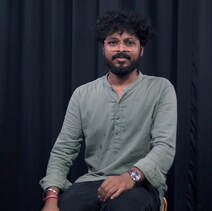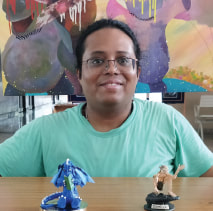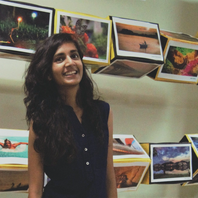On Going
Prarthana Majumdarprarthana.majumdar [at] iitg.ac.in
Design for Do-It-Yourself in Emerging Countries for the Rural and Semi-Urban Context.
Supervisor: Dr. Sharmistha Banerjee |
Shivram KumarPedagogic pathways to sustainable development of crafts and craftsperson
Supervisor: Dr. Sharmistha Banerjee |
Saptarshi SamantaExploration of application of haptic modalities for improving user experience and immersion in digital gamesSupervisor: Dr. Pankaj Upadhyay
|
Aradhna MoktanCommunity Based Disaster Risk Management
|
Baishalee SonowalA Design support for assessing and designing products for environmentally sustainable end-of-life performanceSupervisor: Dr. Sharmistha Banerjee & Dr. Pankaj Upadhyay
Pankaj KavidayalSupervisor: Dr. Sharmistha Banerjee
|
Ankit Basakankit.basak [at] iitg.ac.in
Design for Social Innovation
Supervisor: Dr. Pankaj Upadhyay
Beda Prakash Dasd.beda [at] iitg.ac.in
Industrial Design Visualization
Supervisor: Dr. Pankaj Upadhyay
|
Completed
Shiva Ji
shivaji [at] des.iith.ac.in
Enhancing sustainability criteria in GRIHA* standards for the built environment in India (*: Green Rating for Integrated Habitat Assessment)
Supervisor: Professor Ravi Mokashi Punekar
Supervisor: Professor Ravi Mokashi Punekar
July 2023- April 2024
Alfas khader C
A solution for effective cardiopulmonary resuscitation (CPR)
Pragati Murathia
Optimizing Energy Consumption in Residential Sector
Diganggana Bhardwaj
Design for financial independency in rural sector for the sustainable development of crafts and craftsperson
Udayanka B
Material-Driven Electronic Product Design Using North-East Indian Materials
|
Abhishek Kunta
Redesigning the rice transplanter for the context of Assam
Rohan Rajeev
Independent lifestyle rehabilitation device for the elderly
Niharika
Hindi language learning in education for children in primary classes
Saranya Anandha Krishnan
Semi-Urban Women Makers in Assam: Research, Analysis and Design Interventions for Sustainability
|
Rucha Pramod Patil
Artha (अर्थ ) - A Device For Children With Autism To Learn Real-Life Currency Transactions
Ashik Purushotham
Redesign of ICS Toolkit
Siddharth Sethi
Device for early detection of respiratory distress in infants
Bivob Bhuyan
Fun Mobility for Urban Youth
|
July 2022- April 2023
July 2021- April 2022
Phuntsok ChoephelDesign Intervention for Thanka artists in Sikkim
Pranav LokhandeFlood Mitigation with the use of an Information System for Mumbai
|
MuskanIncreased screen time affecting school children in India
|
Anjali VenugopalDesign Intervention for Environmental Sustainability in the Food Delivery Industry
|
July 2019- April 2020
Minakhi DasReimagining older adult's care experience after breaking a bone due to osteoporosis to ensure their first fracture is their last.
|
Abhishek KunjappanDesign of a skull cutter for autopsy
|
Saish GosaviDesigning a controller for a person with a disability to use devices like mobile and computer easily.
|
July 2018 - April 2019
July 2016 - April 2017
July 2023 - April 2024
Amaldev V
Designing Products for the Prevention or Recovery from Sports Injuries.
Arundhati Dileep Malkhede
Toys for Sustainability Education
|
Dhruv Korula
Service-App System to Provide Community and Stimulation to Retired Seniors
Prakhar Shukla
Designing the dashboard for end of life assessment of products
|
Anish Deshpande
Creating optimal educational spaces through furniture
|
July 2021 - April 2022
July 2019 - April 2020
July 2018 - April 2019
July 2016 - April 2017
Present
Past
Sudipta Ghoshsudipta.ghosh [at] iitg.ernet.in
+91-361-2582469 Research Area: Design and development of ginger and turmeric post harvest processing machinery. |
Prarthana Majumdarprarthana.majumdar [at] gmail.com
Research Area: Local crafts (Bamboo, Cane, Kuhila) of Assam and avenues for design intervention. |
Nachiketa MudreInternship & Final Year Bachelor Thesis project
B.Des, Maharaja Ranjit Sinh Gaekwad Institute of Design (MRID), from M.S. University |
Ankit Basakbasak.ankit18 [at] gmail.com
Research Area: Design interventions for fisheries in Assam |
|
Sambeda Nayak
|
Atyushraj Yadav
|
Saheel Mohapatra
|
|
Sunaina Baruah
sunainabaruah1008 [at] gmail.com M.des, Social Design, Ambedkar University |



















































































